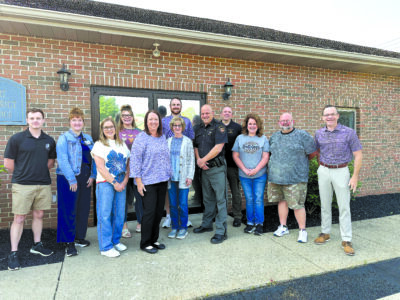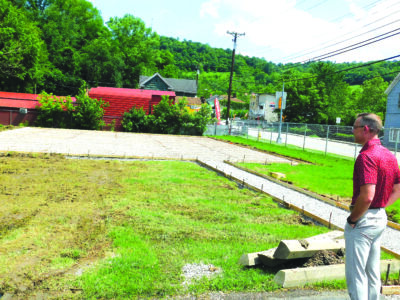Martins Ferry: Plant strives to provide clean, safe water

T-L Photo/SHELLEY HANSON MARTINS FERRY Water Superintendent Bill Suto talks about how the ozone process works to treat raw water into drinking water. The first container, at left, shows raw water, the middle container shows the result of ozone killing bacteria and viruses and bringing minerals to the surface, and the third container shows the treated water after it has been filtered.
MARTINS FERRY — City officials want residents to know that making Martins Ferry’s water safe to drink is something they take seriously, because they drink the water, too, as do their own families and friends.
This was the sentiment expressed by Water Superintendent Bill Suto, Water Operator of Record Donnie Neavin and Mayor John Davies during a recent tour of the facility by The Times Leader.
The plant was built about 25 years ago and uses a disinfection system called ozone to clear the water of unwanted contaminants and minerals.
The tour comes on the heels of concerns expressed by local environmental group Concerned Ohio River Residents about the Austin Master Services plant.
The Austin Master plant processes radioactive waste from the fracking industry.
CORR has expressed concern mainly about the radioactive substance radium possibly getting into the groundwater or aquifer.
City officials said this scenario is unlikely, not only because of how the Austin Master plant operates, but also because of its location. It is situated in the former Wheeling-Pittsburgh Steel building that features a concrete floor.
And the aquifer is located down the road from that building on a gravel road that is not used by trucks entering the Austin Master facility.
“No one has got anything to hide here. We try to do the right things,” Suto said of the plant.
Suto said the city water’s radium level is below the Ohio Environmental Protection Agency’s allowable limit for drinking water. He added that the level has even decreased over the past several years.
A recent raw water sample showed radium-226 at 0.8 picocuries per liter (pCi/L) and radium-228 at 0.679 pCi/L. Combined, these raw water measurements total 1.479 pCi/L — well below the maximum contaminant level for radium in treated drinking water, which is 5 pCi/L, according to the Ohio EPA.
The city had its treated water tested as well. For radium-226 the level was 0.552 pCi/L, and for radium-228 the level was 0.631 pCi/L, totaling 1.183pCi/L for combined radium.
Water treatment workers test water samples daily for a variety of other contaminants not only at the facility, but at 35 different points across the water system.
“We are 100 percent in compliance and are determined to stay in compliance no matter what changes come about,” Suto said, noting the Ohio EPA often makes changes to its drinking water standards.
He noted one of the newer standards involves per- and polyfluoroalkyl substances. OEPA testing has shown there are no PFAS in Martins Ferry’s eight wells in its well field, Suto said.
PFAS were found in one of the village of Bridgeport’s wells, which led to the village discontinuing use of them and starting to purchase drinking water from the city of Martins Ferry.
According to OEPA, PFAS are chemicals found in a variety of manmade materials such as packaging and household products. PFAS are believed to be harmful, as they can build up in living things’ bodies, including people, and can cause adverse health effects.
“We’re doing everything and more than what the EPA is requiring,” Suto added.
The city’s treatment plant uses a form of disinfection called ozone, which is produced by the use of oxygen and high voltage electricity that leads to the destruction of cells. The leftover material is filtered from the water and is sent via pipeline to the East Ohio Regional Water Authority’s wastewater treatment plant.
Suto added the city hits the treated water with some chlorine before it leaves the plant so when they grab samples across the system they know it is indeed the treated water being sampled.
Regarding the aquifer drawn from, Suto said it is the same aquifer that originates in the Lake Erie area and that is used by millions of people.
“I’m very proud of our water and our guys and what we do here,” Suto said. “If someone wants to tour the place, they can.”
Davies also feels strongly about protecting the water treatment plant but does not believe it or the aquifer is in danger from the Austin Master Services facility.
“If Austin Master did something to jeopardize the water, we would want them shut down if they did something wrong and did not fix it, if it was serious enough to talk to the EPA,” he said.
On a side note, the CORR group is set to conduct an unrelated protest of the proposed Belmont County PTT Global cracker plant starting about 11 a.m. today. The event will begin on Wheeling Island and proceed south to Moundsville where people are slated to speak at Riverfront Park.




